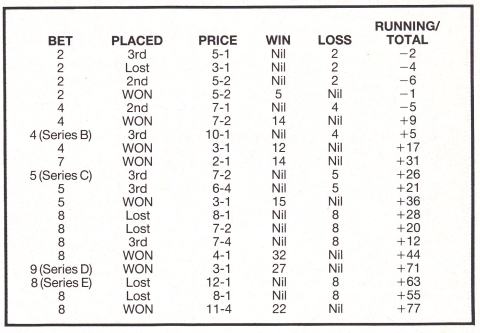The legendary punter Eric Connolly handed out a lot of advice during his time - but none so sensible as that which warned punters to bet cautiously.
Connolly always said that if you were using a method of progression betting, that you had to do so using only proven, consistent horses. Increasing your stakes race-by-race, he said, was a most dangerous idea because of the possibility of a long losing streak.
He pointed out, though, that if you were to use a progression betting plan on good, consistent horses then you would be unlikely to be hammered into submission by the long losing runs. His reasoning was that a 'stable' of specially-selected horses would give you a limited number of bets and would not push you into a steep race-by-race progression.
What you have to do to follow this chart staking plan is to select a 'stable' of horses, but they must be horses with good performance records. It may well be that you can restrict membership of your stable to horses with at least 20% win average from all starts (with a minimum of eight starts). Horses which have averaged 20% plus for a season can be reasonably expected - barring injury and illness - to continue in such a winning vein again.
Here, I suggest that you use Brian Blackwell's book of 100 Horses To Follow for 1986-87 as the basis for selecting the stable of horses. I would urge you to have two stables of 10 horses each say a Melbourne stable and a Brisbane stable. Brian's book has won wide acclaim and the winners began rolling in as soon as the new season started (Just Now at 12s after 16s were bet, for one, and lmaguy at 6-1 on the TAB for another). Pick your horses from his file of 100 and you can't go wrong.
Ten horses is quite sufficient because you don't want a stable that is too unwieldy, and nor do you want your stable horses clashing in the same races too often.
Once you have a stable selected, you then back each member of it every time they run and you progress from horse to horse. If you have two horses in the same race, you back both, having the same stake on each, but if you find three or more in the same race - forget it.
The suggested progressive staking on the chart is as follows:
THE STAKING CHART
| Series | Series | Series | Series | Series |
|---|
| A | B | C | D | E |
| 2 | 3 | 4 | 5 | 6 |
| 3 | 4 | 5 | 6 | 7 |
| 4 | 5 | 6 | 7 | 8 |
| 5 | 6 | 7 | 8 | 9 |
| 6 | 7 | 8 | 9 | 10 |
This is how you should apply the progression table, according to the prices of each horse, and remember that this progression is used only after a winner is struck.
THE PROGRESSION
| HORSE'S PRICE | GO FORWARD |
|---|
| Under 2-1 | One step |
| 2-1 to 5-2 | Two steps |
| 11-4 to 3-1 | Three steps |
| 7-2 | Four steps |
| 4-1 | Five steps |
| Over 4-1 | Six steps |
Now, every time you strike a loser you remain on the same stake as you bet. You only go forward when you win - and you follow the above progression list to determine how far forward you go. For instance, if you have just backed a 5-2 winner, you advance two steps.
Our plan operates very simply, but very effectively, in cycles of five bets. It is aimed at punters who operate on a limited basis - and thus the reason for the stable of horses. This fact alone will allow you to operate this progression method on a sane basis.
Now I'll take you through a sample betting action. You begin with Series A with a bet of two units (we'll assume a unit is $1, so that will be $2 to bet). Let's say that your first bet loses. Your second bet will again be a two unit bet and if this happens to win at, say, 2-1, you would then go forward two steps, making your next bet $4. If the next bet won at, say, 4-1, you would then progress five steps, making your next bet $5 in Series B.
You can see from this, that you leapfrog easily from series to series. You can, if you wish, rule off and start all over again once you have made a certain profit, but my own method is to work all the way through the five series before calling a halt and starting again.
The important point about this method is that it has to be operated in a controlled and sensible manner. You need a good winning percentage to extract the best results from it.
Here is a recent list of bets that 1 had:

This ends the series of bets. The total then is as follows: STAKE $111, PROFITS $141, LOSSES $64. TOTAL PROFIT $77. This is a return of 69.3% on turnover.
This particular progression took 15 weeks to complete. I was betting in $50 units, so my profit was substantial. I have been following this chart method for a long time now, as an adjunct to my other betting activities, and I can tell you that time after time it has provided me with a quarterly boost to my finances.
I heartily recommend this chart method. In the above sample, I had 20 bets for eight winners, at an average price of 2.96-1.
By Des Green
PRACTICAL PUNTING - OCTOBER 1986